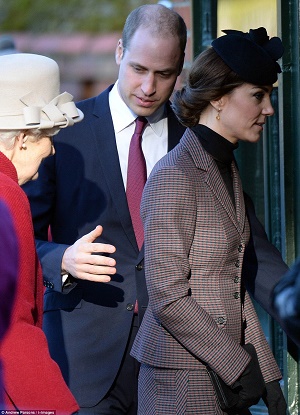 Has Prince William finally embraced his balding pate, as suggested by the Daily Mail in January, or has he simply had his hair cut more closely than usual in readiness for an appointment with his hair transplant specialist? The prince has been losing his hair steadily for several years now, but for just as long, he has continued to wear his hair as though he still had the thick, towselled mop of his teens. It became evident last month, though, that he was ready to acknowledge to the world that this was no longer the case, as he attended a church service in Norfolk to commemorate the 100th anniversary of the Gallipoli campaign, sporting a buzz cut.
Has Prince William finally embraced his balding pate, as suggested by the Daily Mail in January, or has he simply had his hair cut more closely than usual in readiness for an appointment with his hair transplant specialist? The prince has been losing his hair steadily for several years now, but for just as long, he has continued to wear his hair as though he still had the thick, towselled mop of his teens. It became evident last month, though, that he was ready to acknowledge to the world that this was no longer the case, as he attended a church service in Norfolk to commemorate the 100th anniversary of the Gallipoli campaign, sporting a buzz cut.
Why is the prince losing his hair?
Prince William is probably experiencing androgenetic alopecia – or male pattern baldness. It also affects women and is known as female pattern hair loss. The earliest signs of the condition include noticeable hair shedding and the growth of much finer hair strands over time. Hair loss occurs gradually over several years. In men the hair loss occurs initially from the temples and frontal hair line, and gradually recedes toward the crown. In women, hair loss tends to be centred on the crown and rarely, at the temples and frontal hair line. Men are much more likely to experience complete baldness than women, for whom noticeably thinner hair is more common.
As the name suggests, androgenetic alopecia is a genetic condition, and it used to be commonly believed to be a condition that is inherited on the maternal side. However, it is now known that the genetic code, contained within the chromosomes, can be inherited from either the mother or the father. Furthermore, for male pattern baldness to develop, the gene must also be expressed – it is not sufficient to be a carrier of the gene. Scientists have not yet identified the specific gene that is responsible for hair loss, but it is believed that genes that are involved in male hormone synthesis, 5-alpha reductase (an enzyme), and androgen receptors in the hair follicle are the key genes since they are all involved in male pattern baldness.
What can Prince William do about male pattern baldness?
While androgenetic alopecia is actually extremely common in men – affecting about 50% of men and more likely to occur in white men than in men of Asian or African descent – it is nevertheless an unwelcome sign of aging for many. Culturally and evolutionarily, we make sweeping judgements about people based on their appearance, and balding is a visual indicator of reduced fertility in a man, making him a less desirable mate. Luckily the prince managed to secure a mate and produce an heir and a spare before his male pattern balding really took hold, but if he hadn’t, there were plenty options available to him that would allow him to retain his masculine desirability levels.
Topical treatments that have been approved by the American Food and Drugs Administration (FDA) work by limiting the production of testosterone in the hair follicles, thus enabling them to continue to grow. This is because a feature of androgenetic alopecia is the inherited sensitivity to a by-product of testosterone (dihydrotestosterone).
Therefore, by suppressing testosterone in the hair follicles, there will be no adverse follicular reaction to its by-product, and the hair will continue to grow. Finasteride and minoxidil (better known as Propecia and Rogaine) should be applied twice daily to protect the hair follicles.
Hair transplant is a highly successful treatment for well-established hair loss, such as the prince is experiencing. This procedure involves harvesting hair follicles from the back of the head and relocating them on the hair line where loss has occurred. While it may take as long as 12 months for the long term effects to be really noticeable, it is a popular solution.
A healthy diet, herbal treatments, and good hair and scalp care are also important for those who wish to retain what hair they have for as long as possible. Some studies suggest that a diet and lifestyle low in essential fatty acids, protein, and Vitamin D can also trigger hair loss.
As for Prince William – only time will tell whether he has decided to seek treatment, or simply go bald gracefully!

